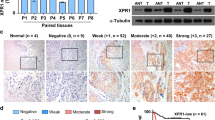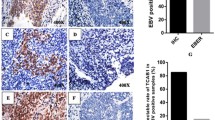Abstract
Bladder cancer-associated protein gene (BLCAP) is a novel candidate tumor suppressor gene identified from the human bladder carcinoma. Our previous studies have shown that BLCAP overexpression could inhibit cell growth by inducing apoptosis in HeLa cells [Zuo Z, Zhao M, Liu J, Gao G, Wu X: Tumor Biol 27: 221–226, 2006]. Such evidence suggests the alterations in BLCAP may play an important role in tumorigenesis. To further study the biological function of the BLCAP gene, we constructed a recombinant retroviral vector encoding BLCAP cDNA. Overexpressed BLCAP, via stable infection of exogenous BLCAP, resulted in growth inhibition of the human tongue cancer cell line Tca8113 in vitro, accompanied by S phase cell cycle arrest and apoptosis. The growth inhibition was correlated with up-regulation of p21WAF1/CIP1 expression and down-regulation of Bcl-XL and Bcl-2 expressions. However, p53 expression and NF-κB activity remained unchanged post infection. Furthermore, no changes in p53 phosphorylation at Ser46 and nuclear localization, which are critical to p53 function, were observed in BLCAP-overexpressed cells. Taken together, BLCAP may play a role not only in regulating cell proliferation but also in coordinating apoptosis and cell cycle via a novel way independent of p53 and NF-κB.
Similar content being viewed by others
Abbreviations
- BLCAP:
-
bladder cancer-associated protein gene
- NF-κB:
-
nuclear factor kappa B
- Bcl-2:
-
B-cell lymphocytic-leukaemia proto-oncogene 2
- MTT:
-
methylthiazole tetrazolium
- EMSA:
-
electrophoretic mobility shift assay
- DMSO:
-
dimethyl sulphoxide
- SCCHN:
-
squamous cell carcinoma of the head and neck
- PI:
-
propidium iodide
- PVDF:
-
polyvinylidene difluoride
- CDK:
-
cyclin-dependent kinase
References
Landis SH, Murray T, Bolden S, Wingo PA (1999) Cancer statistics CA Cancer J Clin 49: 8–31
Pignon JP, Bourhis J, Domenge C, Designe L (2000) Chemotherapy added to locoregional treatment for head and neck squamous-cell carcinoma: three meta-analyses of updated individual data. MACH-NC Collaborative Group. Meta-analysis of chemotherapy on head and neck cancer Lancet 355: 949–955
Boring CC, Squries TS, Tong T, Montgomery S (1994) Cancer statistics CA Cancer J Clin 44: 7–26
Shang ZJ, Li JR, Li ZB (2002) Effects of exogenous nitric oxide on oral squamous cell carcinoma: an in vitro study J Oral Maxillofac Surg 60: 905–910
Makalowski W, Boguski MS (1998) Evolutionary parameters of the transcribed mammalian genome: an analysis of 2,820 orthologous rodent and human sequences Proc Natl Acad Sci USA 95: 9407–9412
Holt MR, Koffer A (2001) Cell motility: proline-rich proteins promote protrusions Trends Cell Biol 11: 38–46
Gromova I, Gromov P, Celis JE (2002) bc10: A novel human bladder cancer-associated protein with a conserved genomic structure downregulated in invasive cancer Int J Cancer 98: 539–546
Su HC, Zhao YH, Fan DG, Fan QY, Zhang P, Wen YH, Liu YY (2003) Relationship between expression of BLCAP protein and malignancy of osteosarcoma Xi Bao Yu Fen Zi Mian Yi Xue Za Zhi 19: 465–466
Fan D-G, Fan Q-Y, Zhang H-Z, Zhang Y-H, Liu Y-Y (2004) A prospective genetic therapy study of extremity saving operations: the regulatory function of gene BLCAP in the development of human osteosarcoma Chin J Clin Rehab 8: 982–983
Zuo Z, Zhao M, Liu J, Gao G, Wu X (2006) Functional analysis of bladder cancer-related protein gene: a putative cervical cancer tumor suppressor gene in cervical carcinoma Tumor Biol 27: 221–226
Rojanasakul Y, Ye J, Chen F, Wang L, Cheng N, Castranova V, Vallyathan V, Shi X (1999) Dependence of NF-κB activation and free radical generation on silica-induced TNF-α production in macrophages Mol Cell Biochem 200: 119–125
Sherr CJ, Roberts JM (1999) CDK inhibitors: positive and negative regulators of G1-phase progression Genes Dev 13: 1501–1512
Oda K, Arakawa H, Tanaka T, Matsuda K, Tanikawa C, Mori T, Nishimori H, Tamai K, Tokino T, Nakamura Y, Taya Y (2000) p53AIP1, a potential mediator of p53-dependent apoptosis, and its regulation by Ser-46-phosphorylated p53 Cell 102: 849–862
Pahl HL (1999) Activators and target genes of Rel/NFkappaB transcription factors Oncogene 18: 6853–6866
Huerta-Yepez S, Vega M, Jazirehi A, Garban H, Hongo F, Cheng G, Bonavida B (2004) Nitric oxide sensitizes prostate carcinoma cell lines to TRAIL-mediated apoptosis via inactivation of NF-kappa B and inhibition of Bcl-xl expression Oncogene 23: 4993–5003
Carson DA, Ribeiro JM (1993) Apoptosis, disease Lancet 341: 1251–1254
Yi X, Wang J, Seol D-W, Dong Z (2006) Characterization of cell clones stably transfected with short form caspase-9: apoptotic resistance and Bcl-XL expression Mol Cell Biochem 282: 1–12
Antonsson B (2004) Mitochondria and the Bcl-2 proteins in apoptosis signaling pathways Mol Cell Biochem 256–257: 141–155
Hockenbery DM, Oltvai ZN, Yin X-M, Milliman C, Korsmeyer SJ (1993) Bcl-2 functions in an antioxidant pathway to prevent apoptosis Cell 75: 241–251
de Vicente JC, Olay S, Lequerica-Fernandez P, Sanchez-Mayoral J, Junquera LM, Fresno MF (2006) Expression of Bcl-2 but not Bax has a prognostic significance in tongue carcinoma J Oral Pathol Med 35: 140–145
Kitamura Y, Ota T, Matsuoka Y, Tooyama I, Kimura H, Shimohama S, Nomura Y, Gebicke-Haerter PJ, Taniguchi T (1999) Hydrogen peroxide induced apoptosis mediated by p53 protein in glial cells Glia 25: 154–164
Nakamura T, Sakamoto K (2001) Reactive oxygen species up-regulate cyclooxygenase-2, p53, and Bax mRNA expression in bovine luteal cells Biochem Biophys Res Commun 284: 203–210
Chen QM, Liu J, Merrett JB (2000) Apoptosis or senescence-like growth arrest: influence of cell-cycle position, p53, p21 and Bax in H2O2 response of normal human fibroblasts Biochem J 347: 543–551
Brugarolas J, Moberg K, Boyd SD, Taya Y, Jacks T, Lees JA (1999) Inhibition of cyclin-dependent kinase 2 by p21 is necessary for retinoblastoma protein-mediated G1 arrest after γ-irradiation Proc Natl Acad Sci USA 96: 1002–1007
Allan LA, Duhig T, Read M, Fried M (2000) The p21(WAF1/CIP1) promoter is methylated in Rat-1 cells: stable restoration of p53-dependent p21(WAF1/CIP1) expression after transfection of a genomic clone containing the p21(WAF1/CIP1) gene Mol Cell Biol 20: 1291–1298
Levine AJ (1997) p53, the cellular gatekeeper for growth and division Cell 88: 323–331
Gartel AL, Tyner AL (2002) The role of the cyclin-dependent kinase inhibitor p21 in apoptosis Mol Cancer Ther 1: 639–649
Chen J, Jackson PK, Kirschner MW, Dutta A (1995) Separate domains of p21 involved in the inhibition of cdk kinase and PCNA Nature 374: 386–388
Ogryzko VV, Wong P, Howard BH (1997) WAF 1 retards S-phase progression primarily by inhibition of cyclin-dependent kinases Mol Cell Biol 17: 4877–4882
Zhu H, Zhang L, Wu S, Teraishi F, Davis JJ, Jacob D, Fang B (2004) Induction of S-phase arrest and p21 overexpression by a small molecule 2[[3-(2,3- dichlorophenoxy)propyl] amino]ethanol in correlation with activation of ERK Oncogene 23: 4984–4992
Agarwal C, Ravikanth V, Thompson JA, Agarwal R (2005) Biofractionation of GSE: identification of gallic acid as one of the major active constituents causing growth inhibition, S phase arrest and apoptotic death of DU145 human prostate carcinoma cells AACR Meeting Abstracts 2005: 1227
Shenberger JS, Dixon PS (1999) Oxygen induces S-phase growth arrest and increases p53 and p21(WAF1/CIP1) expression in human bronchial smooth-muscle cells Am J Respir Cell Mol Biol 21: 395–402
Acknowledgment
This project was supported by the National Natural Science Foundation of China (No. 30250008).
Author information
Authors and Affiliations
Corresponding author
Additional information
Jun Yao and Li Duan contributed equally to this work.
Rights and permissions
About this article
Cite this article
Yao, J., Duan, L., Fan, M. et al. Overexpression of BLCAP induces S phase arrest and apoptosis independent of p53 and NF-κB in human tongue carcinoma. Mol Cell Biochem 297, 81–92 (2007). https://doi.org/10.1007/s11010-006-9332-2
Received:
Accepted:
Published:
Issue Date:
DOI: https://doi.org/10.1007/s11010-006-9332-2




